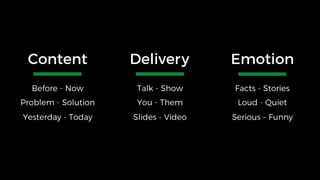The Secret to Engaging Presentations
0 likes903 views
This presentation was used as part of my talk at both ITCAMP 2017 in Romania and Tarabica IT in Serbia.
1 of 47















































Ad
Recommended
Presentation Design Fundamentals
Presentation Design FundamentalsBoris Hristov
╠²
The document discusses presentation design fundamentals by Boris Hristov, emphasizing the importance of simplicity, careful font selection, and effective use of space and colors. It highlights key concepts in business intelligence, data transformation, and the necessity of design in various contexts. Resources and contact information for further inquiries are provided.The World of Business Intelligence
The World of Business IntelligenceBoris Hristov
╠²
This document provides an overview of business intelligence. It defines business intelligence as transforming data into knowledge. It discusses data warehouses as single points of truth that store large amounts of differently designed data. It demonstrates extracting information from data warehouses using T-SQL and visualizing data in Excel models and Power BI reports to provide ready analytics to managers in a beautiful way.The 5 Hidden Performance Gems of SQL Server 2014
The 5 Hidden Performance Gems of SQL Server 2014Boris Hristov
╠²
Boris Hristov, an SQL Server MVP, discusses key performance improvements in SQL Server 2014, focusing on features like delayed durability, parallel execution plans, and the importance of the cardinality estimator. He emphasizes the need for proper database design and thorough testing to maximize performance gains. The presentation includes demos and highlights partitioning improvements, along with resources for further exploration.Securing SQL Azure DB? How?
Securing SQL Azure DB? How?Boris Hristov
╠²
The document discusses SQL Server MVP Boris Hristov's presentation at SQL Saturday Rheinland 2015, focusing on security features such as dynamic data masking and row-level security in SQL Azure DB. It emphasizes the importance of protecting sensitive data and managing user access effectively. The session includes examples and demonstrations to illustrate these concepts.The Nightmare of Locking, Blocking and Isolation Levels!
The Nightmare of Locking, Blocking and Isolation Levels!Boris Hristov
╠²
The document discusses transaction locking, blocking, and isolation levels in SQL Server, highlighting the importance of managing locks to protect resources and ensure data consistency. It differentiates between various types of locks, their compatibility, and methods for troubleshooting locking issues, including lock escalation and deadlocks. Additionally, it emphasizes the need to monitor locking behaviors and carefully choose isolation levels as part of a business decision.How to Deliver Technical Presentations: The Right Way!
How to Deliver Technical Presentations: The Right Way!Boris Hristov
╠²
The document outlines a presentation skills workshop led by Boris Hristov, emphasizing the importance of preparation, audience engagement, and effective communication techniques. Key points include practicing extensively, structuring presentations, and managing technical aspects to ensure smooth delivery. The session also covers non-verbal communication, the significance of strong openings and conclusions, and the necessity of seeking feedback.Securing SQL Azure DB? How?
Securing SQL Azure DB? How?Boris Hristov
╠²
The document outlines a presentation by Boris Hristov, an SQL Server MVP, on securing SQL Azure databases, highlighting features like dynamic data masking and row-level security. It emphasizes the capabilities to mask sensitive data and control user access to rows based on security policies. Additionally, it mentions upcoming events related to SQL Server, including SQL Saturday #384 in Varna.Top 5 T-SQL Improvements in SQL Server 2014
Top 5 T-SQL Improvements in SQL Server 2014Boris Hristov
╠²
The document discusses key T-SQL improvements in SQL Server 2014 as presented by Boris Hristov, highlighting features such as delayed durability, new execution plans, cardinality estimator enhancements, inline index definitions, and improvements in partitioning. Hristov emphasizes the importance of proper database design and testing for optimal performance. Resources for further information and feedback are also provided.Presentation Skills: The Next Level
Presentation Skills: The Next LevelBoris Hristov
╠²
The document outlines key presentation skills and techniques for effective speaking, emphasizing the importance of audience engagement and preparation. It highlights the need for structure, practice, and the use of non-verbal communication, while also addressing common challenges like stage fright. Additionally, it encourages asking for feedback to improve future presentations.The Nightmare of Locking, Blocking and Isolation Levels!
The Nightmare of Locking, Blocking and Isolation Levels!Boris Hristov
╠²
The document presents an overview of locking, blocking, and transaction isolation levels in SQL Server, emphasizing the importance of understanding concurrency control methods. It outlines the different types of locks, compatibility, and escalation, as well as troubleshooting techniques for locking problems. Additionally, it discusses various transaction isolation levels and their impact on data consistency and concurrency, advising careful consideration in choosing isolation levels.SQL Server 2014: Ready. Steady. Go!
SQL Server 2014: Ready. Steady. Go!Boris Hristov
╠²
The document outlines various performance optimization techniques in SQL Server 2014, including delayed durability, table partitioning, and the use of in-memory OLTP (Hekaton). It discusses the benefits and limitations of these methods in enhancing application speed and efficiency. The presentation emphasizes the importance of these techniques for achieving significantly faster database operations.BI PoC for the Telco Industry
BI PoC for the Telco IndustryBoris Hristov
╠²
Boris Hristov, a SQL Server consultant from Bulpros, highlights challenges faced in reporting and understanding business needs, noting that the CFO has ceased inquiries about reports. The document emphasizes the necessity of gathering solution requirements effectively. Communication is a critical factor in addressing these reporting issues.Presentation Design Basics
Presentation Design BasicsBoris Hristov
╠²
The document outlines fundamental principles of presentation design, emphasizing the importance of simplicity, restraint, and the effective use of fonts, colors, and images. It discusses various design elements such as charts and graphs, along with the significance of maintaining a clean and professional layout. Additionally, it encourages starting with analog methods and highlights design inspiration resources.Deep Into Isolation Levels
Deep Into Isolation LevelsBoris Hristov
╠²
The document discusses various SQL isolation levels including optimistic and pessimistic concurrency, with a focus on their impact on transactions, locking mechanisms, and potential conflicts. It details the types of locks (shared, update, exclusive) and their compatibility in the context of database operations, along with methods to monitor locking information. The importance of choosing appropriate isolation levels for business decisions and application performance is emphasized.Top 5 T-SQL Improvements in SQL Server 2014
Top 5 T-SQL Improvements in SQL Server 2014Boris Hristov
╠²
The document discusses five significant T-SQL improvements introduced in SQL Server 2014, including delayed durability, parallel execution plans, an updated cardinality estimator, inline index definitions, and enhanced partitioning features. It emphasizes the importance of proper database design for performance and encourages thorough testing of queries due to changes in estimations. Additional resources for further learning are also provided.Database Transactions and SQL Server Concurrency
Database Transactions and SQL Server ConcurrencyBoris Hristov
╠²
The document discusses database transactions and transaction management. It begins with an overview of transactions, their properties (atomicity, consistency, isolation, durability known as ACID), and how they are implemented using locks in SQL Server. It then covers transaction isolation levels, locking concepts like lock types and escalation, and how to troubleshoot locking problems including deadlocks. The document provides examples of transactions in SQL Server and demonstrations of managing transactions and concurrency.Database Performance
Database PerformanceBoris Hristov
╠²
This document discusses database performance factors for developers. It covers topics like query execution plans, table indexes, table partitioning, and performance troubleshooting. The goal is to help developers understand how to optimize database performance. It provides examples and recommends analyzing execution plans, properly indexing tables, partitioning large tables, and using a structured approach to troubleshooting performance issues.You want rules? You need Policy-Based Management!
You want rules? You need Policy-Based Management!Boris Hristov
╠²
The document outlines Policy-Based Management (PBM) in SQL Server, highlighting its components like facets, conditions, and evaluation modes, available in various SQL Server editions. It emphasizes centralized management features introduced in SQL Server 2008 that enhance script execution and policy evaluation. Additionally, it offers resources for further learning about SQL Server PBM.The Nightmare of Locking, Blocking and Isolation Levels!
The Nightmare of Locking, Blocking and Isolation Levels!Boris Hristov
╠²
The document discusses locking, blocking, and transaction isolation levels in SQL Server, explaining the mechanisms and types of locks, as well as the concepts of locking and blocking. It further details methods to view locking information and strategies to troubleshoot locking issues including lock escalation and deadlocks. The document concludes with a summary emphasizing the normalcy of blocking, methods to monitor it, and the importance of selecting an appropriate isolation level.The Nightmare of Locking, Blocking and Isolation Levels!
The Nightmare of Locking, Blocking and Isolation Levels!Boris Hristov
╠²
The document discusses SQL Server locking, blocking, and transaction isolation levels, outlining different types of locks, their compatibility, and methods for troubleshooting locking problems. It explains concepts such as deadlocks, lock escalation, and various transaction isolation levels including pessimistic and optimistic concurrency control. Additionally, it emphasizes the importance of careful management of locks and isolation levels in multiuser environments to ensure data integrity and performance.The Nightmare of Locking, Blocking and Isolation Levels!
The Nightmare of Locking, Blocking and Isolation Levels!Boris Hristov
╠²
This document provides an overview of locking, blocking, and transaction isolation levels in SQL Server. It begins with an introduction to locking and how SQL Server uses locks for concurrency control. It then discusses the different lock types, lock compatibility, and the lock hierarchy. The document demonstrates how to view locking information and troubleshoot locking problems. It also covers lock escalation, deadlocks, and resolving blocking issues. Finally, it concludes with an explanation of the various transaction isolation levels supported by SQL Server and how they differ in terms of concurrency and consistency.The Nightmare of Locking, Blocking and Isolation Levels
The Nightmare of Locking, Blocking and Isolation LevelsBoris Hristov
╠²
The document discusses SQL Server locking, blocking, and isolation levels presented at SQLSaturday 323 in Paris. It explains different types of locks, issues like deadlocks and lock escalation, and strategies for controlling these problems, including choosing appropriate transaction isolation levels. The importance of monitoring locking behavior and making informed decisions about concurrency control is emphasized throughout the presentation.Welcome to the nightmare of locking, blocking and isolation levels!
Welcome to the nightmare of locking, blocking and isolation levels!Boris Hristov
╠²
The document discusses transaction locking and isolation levels in SQL Server. It outlines the types of locks, the difference between locking and blocking, as well as how to troubleshoot locking issues. Key recommendations include minimizing transaction duration and strategically selecting isolation levels to enhance concurrency control.First Steps with Microsoft SQL Server
First Steps with Microsoft SQL ServerBoris Hristov
╠²
This document provides an introduction to Microsoft SQL Server. It discusses why data is important for businesses, how SQL Server helps manage data, and an upcoming hands-on session to learn SQL Server 2014. The document outlines the history and components of SQL Server, editions available, how to install and connect to SQL Server instances, and introduces SQL Server Management Studio as the GUI tool. It concludes with a planned Q&A session.Welcome to the nightmare of locking, blocking and isolation levels!
Welcome to the nightmare of locking, blocking and isolation levels!Boris Hristov
╠²
The document discusses an event on SQL Server locking, blocking, and isolation levels, emphasizing key concepts like types of locks, transaction isolation levels, and methods to troubleshoot locking problems. It explains the differences between locking and blocking and introduces strategies for resolving deadlocks and controlling lock escalation. Additionally, it highlights the importance of monitoring and choosing the appropriate isolation level for optimal concurrency and performance.The nightmare of locking, blocking and isolation levels!
The nightmare of locking, blocking and isolation levels!Boris Hristov
╠²
The document discusses the complexities of locking, blocking, and isolation levels in SQL Server, detailing methods for concurrency control such as pessimistic and optimistic approaches. It defines various lock types, their purposes, and the mechanisms for troubleshooting locking problems, including monitoring tools and strategies for deadlock resolution. The summary emphasizes that blocking is a normal occurrence in multiuser environments and the importance of choosing appropriate isolation levels for optimal database performance.Top 5 TSQL Improvements in SQL Server 2014
Top 5 TSQL Improvements in SQL Server 2014Boris Hristov
╠²
The document features a presentation by Boris Hristov on significant T-SQL improvements in SQL Server 2014, including delayed durability, cardinality estimator changes, and inline index definitions. It emphasizes the importance of transaction lifecycle management and performance optimizations such as parallel execution plans and partitioning enhancements. Hristov concludes by encouraging audience engagement and feedback regarding the session and the overall conference.Replay your workload as it is your actual one!
Replay your workload as it is your actual one! Boris Hristov
╠²
The document discusses the Distributed Replay feature in SQL Server 2012, which allows users to replay workloads for application compatibility, performance testing, and forecasting. It outlines the components necessary for setting up the environment, including tools like the administration tool, controller, clients, and target server. The process involves capturing a workload, preprocessing it, selecting a replay mode, and analyzing the results, emphasizing the importance of documentation and community sharing.More Related Content
More from Boris Hristov (20)
Presentation Skills: The Next Level
Presentation Skills: The Next LevelBoris Hristov
╠²
The document outlines key presentation skills and techniques for effective speaking, emphasizing the importance of audience engagement and preparation. It highlights the need for structure, practice, and the use of non-verbal communication, while also addressing common challenges like stage fright. Additionally, it encourages asking for feedback to improve future presentations.The Nightmare of Locking, Blocking and Isolation Levels!
The Nightmare of Locking, Blocking and Isolation Levels!Boris Hristov
╠²
The document presents an overview of locking, blocking, and transaction isolation levels in SQL Server, emphasizing the importance of understanding concurrency control methods. It outlines the different types of locks, compatibility, and escalation, as well as troubleshooting techniques for locking problems. Additionally, it discusses various transaction isolation levels and their impact on data consistency and concurrency, advising careful consideration in choosing isolation levels.SQL Server 2014: Ready. Steady. Go!
SQL Server 2014: Ready. Steady. Go!Boris Hristov
╠²
The document outlines various performance optimization techniques in SQL Server 2014, including delayed durability, table partitioning, and the use of in-memory OLTP (Hekaton). It discusses the benefits and limitations of these methods in enhancing application speed and efficiency. The presentation emphasizes the importance of these techniques for achieving significantly faster database operations.BI PoC for the Telco Industry
BI PoC for the Telco IndustryBoris Hristov
╠²
Boris Hristov, a SQL Server consultant from Bulpros, highlights challenges faced in reporting and understanding business needs, noting that the CFO has ceased inquiries about reports. The document emphasizes the necessity of gathering solution requirements effectively. Communication is a critical factor in addressing these reporting issues.Presentation Design Basics
Presentation Design BasicsBoris Hristov
╠²
The document outlines fundamental principles of presentation design, emphasizing the importance of simplicity, restraint, and the effective use of fonts, colors, and images. It discusses various design elements such as charts and graphs, along with the significance of maintaining a clean and professional layout. Additionally, it encourages starting with analog methods and highlights design inspiration resources.Deep Into Isolation Levels
Deep Into Isolation LevelsBoris Hristov
╠²
The document discusses various SQL isolation levels including optimistic and pessimistic concurrency, with a focus on their impact on transactions, locking mechanisms, and potential conflicts. It details the types of locks (shared, update, exclusive) and their compatibility in the context of database operations, along with methods to monitor locking information. The importance of choosing appropriate isolation levels for business decisions and application performance is emphasized.Top 5 T-SQL Improvements in SQL Server 2014
Top 5 T-SQL Improvements in SQL Server 2014Boris Hristov
╠²
The document discusses five significant T-SQL improvements introduced in SQL Server 2014, including delayed durability, parallel execution plans, an updated cardinality estimator, inline index definitions, and enhanced partitioning features. It emphasizes the importance of proper database design for performance and encourages thorough testing of queries due to changes in estimations. Additional resources for further learning are also provided.Database Transactions and SQL Server Concurrency
Database Transactions and SQL Server ConcurrencyBoris Hristov
╠²
The document discusses database transactions and transaction management. It begins with an overview of transactions, their properties (atomicity, consistency, isolation, durability known as ACID), and how they are implemented using locks in SQL Server. It then covers transaction isolation levels, locking concepts like lock types and escalation, and how to troubleshoot locking problems including deadlocks. The document provides examples of transactions in SQL Server and demonstrations of managing transactions and concurrency.Database Performance
Database PerformanceBoris Hristov
╠²
This document discusses database performance factors for developers. It covers topics like query execution plans, table indexes, table partitioning, and performance troubleshooting. The goal is to help developers understand how to optimize database performance. It provides examples and recommends analyzing execution plans, properly indexing tables, partitioning large tables, and using a structured approach to troubleshooting performance issues.You want rules? You need Policy-Based Management!
You want rules? You need Policy-Based Management!Boris Hristov
╠²
The document outlines Policy-Based Management (PBM) in SQL Server, highlighting its components like facets, conditions, and evaluation modes, available in various SQL Server editions. It emphasizes centralized management features introduced in SQL Server 2008 that enhance script execution and policy evaluation. Additionally, it offers resources for further learning about SQL Server PBM.The Nightmare of Locking, Blocking and Isolation Levels!
The Nightmare of Locking, Blocking and Isolation Levels!Boris Hristov
╠²
The document discusses locking, blocking, and transaction isolation levels in SQL Server, explaining the mechanisms and types of locks, as well as the concepts of locking and blocking. It further details methods to view locking information and strategies to troubleshoot locking issues including lock escalation and deadlocks. The document concludes with a summary emphasizing the normalcy of blocking, methods to monitor it, and the importance of selecting an appropriate isolation level.The Nightmare of Locking, Blocking and Isolation Levels!
The Nightmare of Locking, Blocking and Isolation Levels!Boris Hristov
╠²
The document discusses SQL Server locking, blocking, and transaction isolation levels, outlining different types of locks, their compatibility, and methods for troubleshooting locking problems. It explains concepts such as deadlocks, lock escalation, and various transaction isolation levels including pessimistic and optimistic concurrency control. Additionally, it emphasizes the importance of careful management of locks and isolation levels in multiuser environments to ensure data integrity and performance.The Nightmare of Locking, Blocking and Isolation Levels!
The Nightmare of Locking, Blocking and Isolation Levels!Boris Hristov
╠²
This document provides an overview of locking, blocking, and transaction isolation levels in SQL Server. It begins with an introduction to locking and how SQL Server uses locks for concurrency control. It then discusses the different lock types, lock compatibility, and the lock hierarchy. The document demonstrates how to view locking information and troubleshoot locking problems. It also covers lock escalation, deadlocks, and resolving blocking issues. Finally, it concludes with an explanation of the various transaction isolation levels supported by SQL Server and how they differ in terms of concurrency and consistency.The Nightmare of Locking, Blocking and Isolation Levels
The Nightmare of Locking, Blocking and Isolation LevelsBoris Hristov
╠²
The document discusses SQL Server locking, blocking, and isolation levels presented at SQLSaturday 323 in Paris. It explains different types of locks, issues like deadlocks and lock escalation, and strategies for controlling these problems, including choosing appropriate transaction isolation levels. The importance of monitoring locking behavior and making informed decisions about concurrency control is emphasized throughout the presentation.Welcome to the nightmare of locking, blocking and isolation levels!
Welcome to the nightmare of locking, blocking and isolation levels!Boris Hristov
╠²
The document discusses transaction locking and isolation levels in SQL Server. It outlines the types of locks, the difference between locking and blocking, as well as how to troubleshoot locking issues. Key recommendations include minimizing transaction duration and strategically selecting isolation levels to enhance concurrency control.First Steps with Microsoft SQL Server
First Steps with Microsoft SQL ServerBoris Hristov
╠²
This document provides an introduction to Microsoft SQL Server. It discusses why data is important for businesses, how SQL Server helps manage data, and an upcoming hands-on session to learn SQL Server 2014. The document outlines the history and components of SQL Server, editions available, how to install and connect to SQL Server instances, and introduces SQL Server Management Studio as the GUI tool. It concludes with a planned Q&A session.Welcome to the nightmare of locking, blocking and isolation levels!
Welcome to the nightmare of locking, blocking and isolation levels!Boris Hristov
╠²
The document discusses an event on SQL Server locking, blocking, and isolation levels, emphasizing key concepts like types of locks, transaction isolation levels, and methods to troubleshoot locking problems. It explains the differences between locking and blocking and introduces strategies for resolving deadlocks and controlling lock escalation. Additionally, it highlights the importance of monitoring and choosing the appropriate isolation level for optimal concurrency and performance.The nightmare of locking, blocking and isolation levels!
The nightmare of locking, blocking and isolation levels!Boris Hristov
╠²
The document discusses the complexities of locking, blocking, and isolation levels in SQL Server, detailing methods for concurrency control such as pessimistic and optimistic approaches. It defines various lock types, their purposes, and the mechanisms for troubleshooting locking problems, including monitoring tools and strategies for deadlock resolution. The summary emphasizes that blocking is a normal occurrence in multiuser environments and the importance of choosing appropriate isolation levels for optimal database performance.Top 5 TSQL Improvements in SQL Server 2014
Top 5 TSQL Improvements in SQL Server 2014Boris Hristov
╠²
The document features a presentation by Boris Hristov on significant T-SQL improvements in SQL Server 2014, including delayed durability, cardinality estimator changes, and inline index definitions. It emphasizes the importance of transaction lifecycle management and performance optimizations such as parallel execution plans and partitioning enhancements. Hristov concludes by encouraging audience engagement and feedback regarding the session and the overall conference.Replay your workload as it is your actual one!
Replay your workload as it is your actual one! Boris Hristov
╠²
The document discusses the Distributed Replay feature in SQL Server 2012, which allows users to replay workloads for application compatibility, performance testing, and forecasting. It outlines the components necessary for setting up the environment, including tools like the administration tool, controller, clients, and target server. The process involves capturing a workload, preprocessing it, selecting a replay mode, and analyzing the results, emphasizing the importance of documentation and community sharing.Recently uploaded (20)
Google Algorithm Updates ŌĆō A Complete Guide for Digital Marketing Students.pdf
Google Algorithm Updates ŌĆō A Complete Guide for Digital Marketing Students.pdfNithinks37
╠²
Explore the most important Google algorithm updates that shaped the SEO landscape from Panda to Helpful Content. This presentation is designed for students and beginners in digital marketing to help them understand how Google's algorithms affect search rankings and how to stay updated with best practices.
¤öŹ WhatŌĆÖs inside:
Overview of key algorithm updates (Panda, Penguin, Hummingbird, BERT, etc.)
Real-life examples of algorithm impacts
SEO tips to align with GoogleŌĆÖs evolving standards
Easy-to-understand explanations for beginners
¤ōÜ Learn more about SEO and digital marketing at ¤æē https://nithinksofficial.com
Whether you're preparing for a course, training session, or just want to improve your SEO skills, this guide will help you build a solid foundation.
#GoogleAlgorithmUpdates #DigitalMarketing #SEOforBeginners #GoogleSEO #LearnSEO #nithinksofficial. https://nithinksofficial.com/Japan's Media and Telecom Markets: Evolution, Global Competition, and NTT Law...
Japan's Media and Telecom Markets: Evolution, Global Competition, and NTT Law...Toshiya Jitsuzumi
╠²
Presentation at ICA2025 in Denver, CO. on June 16, 2025.Analysis of Tausog Language English.pptx
Analysis of Tausog Language English.pptxMervieJadeBabao
╠²
Analysis of Tausog Language English
Analysis of Tausog Language English
Analysis of Tausog Language English
Analysis of Tausog Language English
Analysis of Tausog Language English
Analysis of Tausog Language English
Analysis of Tausog Language English
Analysis of Tausog Language English
Analysis of Tausog Language EnglishFL Studio Crack Full Version [Latest 2025]
FL Studio Crack Full Version [Latest 2025]Jackson lithms
╠²
¤æēØŚĪØŚóØŚ¦ØŚś:ØŚ¢ØŚóØŚŻØŚ¼ ØŚ¤ØŚ£ØŚĪØŚ× & ØŚŻØŚöØŚ”ØŚ¦ ØŚČØŚ╗ØÉōØŚ╝ ØŚÜØŚ╝ØŚ╝ØŚ┤ØŚ╣ØŚ▓ ØŚĪØŚśØŚ¬ ØŚ¦ØŚ«ØŚ»> https://pcprocore.com/ ¤æłŌŚĆ
FL Studio is a powerful digital audio workstation (DAW) used for music production. It's a complete software package that allows users to compose, arrange, record, edit, mix, and master music. Known for its intuitive design, especially for pattern-based music creation, FL Studio is popular among beginners and experienced producers alike.
Josaya - Abstract for the research of the youth development.pdf
Josaya - Abstract for the research of the youth development.pdfJosaya Injesi
╠²
This is my abstract. My first idea on the youPersonal letter personal letter personal letter.pptx
Personal letter personal letter personal letter.pptxGedeJuliana2
╠²
Personal letter personal letter personal letterPersonal letter personal letter personal letterTypes of Information Sources (Primary, Secondary, and Tertiary Sources)
Types of Information Sources (Primary, Secondary, and Tertiary Sources)jenicahmendoza1
╠²
Sources of information come in various forms and serve different educational purposes. Briefing on the upcoming UNFSS +4 Stocktake
Briefing on the upcoming UNFSS +4 StocktakeFrancois Stepman
╠²
2 June 2025. Online network briefing session from the Netherlands Food Partnership about the upcoming UNFSS +4 Stocktake for the Dutch partner network
The global UN FSS+4 Stocktaking Moment (July 27ŌĆō29, 2025, in Addis Ababa, Ethiopia, co-hosted by Ethiopia and Italy) aims to discuss progress made since the UN Food Systems Summit of 2021.
With just five years remaining until the 2030 Agenda for Sustainable Development horizon line, the UNFSS+4 will provide an opportunity to document progress, strengthen accountability, and unlock investments for transformative action.
The event spotlighted:
successful country-level transformations,
innovative practices,
challenges faced in fragile and conflict-affected settings,
and be part of broader efforts to shape a coherent global narrative on sustainable development and accelerate synergies between key SDG transitions.
This is the presentation of Mr. Khaled Eltaweel of the Food Systems Coordination Hub.
Ad
